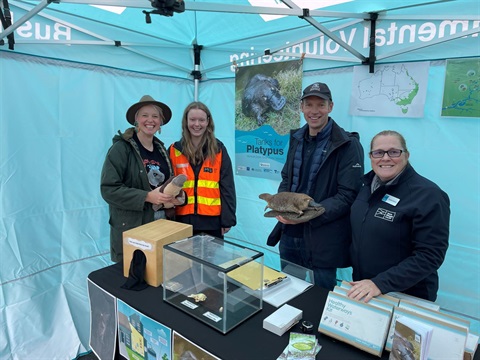
Residents and land managers have put their hands up to improve the health of Monbulk Creek using real-time monitoring and release of water from rainwater tanks and urban lakes as part of the Tanks for Platypus project.
The Tanks for Platypus project uses a smart network of rainwater tanks and urban lakes to provide water for household uses, environmental flows for Monbulk Creek, and to reduce local flooding.
Melbourne Water, the Department of Energy, Environment and Climate Action, the University of Melbourne, South East Water, Yarra Ranges Council, and the Australian Research Council have joined forces with residents in Monbulk to implement this collaborative project.
The Tanks for Platypus project is a priority project for the Dandenong Integrated Water Management (IWM) Forum, which is one of the five IWM Forums in Metropolitan Melbourne established through the Victorian Governments IWM Program. The Victorian Government has provided $778,000 to this project through the Integrated Water Management (IWM) Program.
Lyster Ward Councillor, Johanna Skelton, said the project will be trialed over the next five years, including using rainwater tanks to reduce the impacts of urban stormwater on localised flooding and protect the health of Monbulk Creek and hopefully ensure the Platypus can survive and breed in our area.
The rainwater tanks will be fitted with a real-time monitoring device that will release water at key times to prevent flooding, while making sure water is accessible for households taking part in the project.
South East Water’s Dr David Bergmann said the rainwater tanks fitted with a real-time monitoring device would help reduce the risk of flooding in the hills.
“These tanks can be programmed to release water to the stormwater network before rain events – giving the tank capacity to absorb peak flow rates during rain, reducing the risk of flooding – but also release a steady trickle of water to the creek during dry periods, to sustain flows to support wildlife, including threatened platypus,” he said.
Cr Skelton said that, in addition to supporting the health of Monbulk Creek, this project will support household water use.
“Council is working with community members to install rainwater tanks, which will be operated using real-time control,” she said.
“By using collected water for things like toilets, we’re hopeful our community participants will save money on water bills, too.”
Accompanying the rainwater tanks on private and public properties, large storage lakes at Belgrave Lake Park and Birdsland Reserve will play an important role in the project.
Cr Skelton said the storage lakes and rainwater tanks on private properties would work together to ensure ecosystems in the creek would benefit.
“Good environmental flows aren’t just about the amount of water going into the creek, but the quality and timing of it, and we think this project is going to help sustain and enhance the health of the creek,” she said.
“The first rainwater tank was installed in February, and Council will be sending an invitation to residents in the Monbulk Creek Catchment shortly to get more people involved. It’s such a great opportunity to get a rainwater tank for use at home as well as potentially save a species from local extinction. I know families that have attended the Platypus Festivals, and taken part in the Platypus Education Group will be so pleased to see this collaboration.”
University of Melbourne Professor, Tim Fletcher, said the approach aims to ensure enough water in a stream to provide sufficient nourishment for platypuses before breeding commences, but also reduce pollution from runoff.
“There’s often not enough water in urban streams for platypus, particularly during warmer months of the year,” he said.
“This may be more so in the coming decades with a projected warmer and drier climate for the region.”
“The loss of summer and autumn base flow has major consequences for the platypus distribution and reproductive success, decreasing their habitat and water bugs (their primary food source) right at the time when female platypus need to increase feeding to prepare for breeding the following spring.
“On the other hand, when it rains in urban areas, runoff from hard surfaces like roofs and roads causes erosion, pollution and loss of habitat. Between these two extremes, the platypus is caught between a rock and a hard place.”
Dr Rhys Coleman, Melbourne Water’s Manager of Waterways and Wetland Research, said the project demonstrated how research, technology and community input can help manage water for the benefit of communities and the environment.
“This project delivers Action 35, ‘Disconnecting High Value Waterways’ in the Dandenong IWM Forum’s Strategic Direction Statement, supporting the ecological and waterway health of the creek by ensuring an adequate and sustainable flow of water.
“This will not only enhance the overall biodiversity of the area but also provide a better habitat for various aquatic species.”






